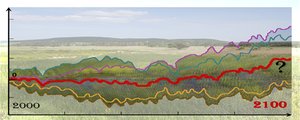The climate modelling research at the Hungarian Meteorological Service (OMSZ) is accomplished with the financial support of national and international projects. The topics and objectives of these projects have been following our development paths and extensions of our activities.
The idea to make steps towards climate dynamics research in Hungary dates back to 2003, its feasibility was ensured by the strong numerical weather prediction team developed in the preceding decade together with the necessary high-capacity computer system. The work started in a national research and development programme entitled “The dynamical meteorological study and characterization of the climate over Hungary based on numerical models” between 2005 and 2007 with leadership of the Hungarian Meteorological Service and partnership of the Eötvös Loránd University, Department of Meteorology, the University of Pécs, Faculty of Sciences, and the Env-in-Cent Ltd. The aim of the co-operation was to establish the regional climate modelling basis in Hungary via adaptation of four regional climate models (ALADIN-Climate, REMO, PRECIS, and RegCM) serving as building bricks for climate change estimations over the Carpathian Basin.

Thanks to these initial steps, the Hungarian Meteorological Service could join the European-wide climate modelling network and co-operations. As a result, OMSZ participated in the CLAVIER and CECILIA EU FP6 projects using ALADIN-Climate and REMO RCMs between 2006 and 2009. Both projects investigated the possible climate change effects on extreme events, circulation patterns, air pollution, agriculture, water- and energy management in the Central and Eastern European region.
The ECCONET EU FP7 project between 2010 and 2012 focused on the estimation of climate change impacts on the European inland waterway transports with emphasis on the Rhine and Danube Rivers. The Hungarian Meteorological Service participated in the work with its modelling expertise and interpretation of the model results. In the framework of the ORIENTGATE project (financed by the South East Europe Programme of the European Union), OMSZ provided data of ALADIN-Climate and REMO RCMs to support the assessments of the influence of increasing heatwave occurrences on the human health in city of Budapest and county of Veszprém in 2013.
The National Adaptation Geo-information System (NAGiS) was established in 2013. In the framework of NAGiS, sectoral impact studies are coordinated to support the adaptation to climate change impacts and related decision making in Hungary. Basis of these impact assessments are the future climate projections given by the simulation results of ALADIN-Climate and RegCM RCMs.
In the RCMGiS project entitled “New climate scenarios based on the change in radiative forcing over the Carpathian Basin”, the improvement of the available climate projections were carried out jointly with the Eötvös Loránd University, Department of Meteorology between 2014 and 2016, applying the most recent model versions, larger integration domains, new lateral boundary conditions and the RCP anthropogenic scenario family. The climate information available in NAGiS was utilized in vulnerability assessment on tourism and critical infrastructures (in the KRIGiS project). These projects are supported by the European Economic Area Grants.
In the KlimAdat project entitled „Assessment of climate change impacts in Hungary with regional climate model simulations and development of a representative climate database” (funded by the European Regional Development Fund and the Cohesion Fund), a gradual extension of the NAGiS projection basis is being achieved from 2016 to 2020: new climate model simulations are ongoing with the ALADIN-Climate and REMO models, the urban impacts of climate change are investigated with the SURFEX/TEB surface model, the consultation with climate information users are continued based on the partnerships of OMSZ.
DECM project also helped in using the climate projections in climate services under the umbrella of the Copernicus Climate Change Services. Main task of OMSZ between 2016 and 2018 were to prepare a catalogue and a data inventory on the ensembles of global and regional climate projections (with focus on the CMIP5 and EURO-CORDEX datasets) from different aspects (Illy et al., 2016, 2017; Szépszó et al., 2017).
References
Illy, T., Szabó, P., Szépszó, G.,Otto, J., Viktor, E., Madsen, M.S., Christensen, O.B. Ruosteenoja, K. (2016): Catalogue on CMIP data provision, applicability and volume. ABC4CDE (C3S_51_Lot4) D2.1 project report, 68 p. [PDF]
Illy, T., Szabó, P., Szépszó, G.,Otto, J., Madsen, M.S., Christensen, O.B., Kämäräinen, M., Mäkelä, A., Ruosteenoja, K. (2017): Catalogue on CORDEX data provision, applicability and volume. DECM (C3S_51_Lot4) D2.2 project report, 74 p. [PDF]
Szépszó, G., Illy, T., Szabó, P., Otto, J., Viktor, E., Madsen, M.S., Christensen, O.B., Kämäräinen, M., Mäkelä, A., Ruosteenoja, K. (2017): Inter-comparison matrix for CMIP and CORDEX data used in climate service. DECM (C3S_51_Lot4) D2.3 project report, 43 p. [PDF]












